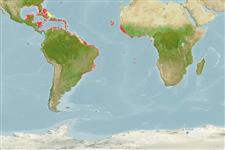Preferred temperature (Ref.
123201): 23.6 - 28.1, mean 27.4 °C (based on 940 cells).
Phylogenetic diversity index (Ref.
82804): PD
50 = 0.5005 [Uniqueness, from 0.5 = low to 2.0 = high].
Bayesian length-weight: a=0.00955 (0.00494 - 0.01846), b=3.09 (2.92 - 3.26), in cm total length, based on LWR estimates for this species & (Sub)family-body (Ref.
93245).
ຊັ້ນເຂດຮ້ອນ (Ref.
69278): 3.6 ±0.2 se; based on diet studies.
ຄວາມຢືດຢຸ່ນ (Ref.
120179): ຂະໜາດກາງ, ປະຊາກອນຕຳ່ສຸດທີ່ໃຊ້ເວລາສອງເທົ່າ 1.4 - 4.4 ປີ (Fec = 5,000).
Fishing Vulnerability (Ref.
59153): Low vulnerability (13 of 100).
Nutrients (Ref.
124155): Calcium = 74.8 [46.2, 116.0] mg/100g; Iron = 0.701 [0.438, 1.126] mg/100g; Protein = 19.1 [18.1, 20.1] %; Omega3 = 0.128 [0.085, 0.193] g/100g; Selenium = 23.6 [13.4, 41.0] μg/100g; VitaminA = 95.9 [35.7, 258.2] μg/100g; Zinc = 1.59 [1.14, 2.15] mg/100g (wet weight);
